Duty cycle

A duty cycle or power cycle is the fraction of one
Equally, a duty cycle (ratio) may be expressed as:
where is the duty cycle, is the pulse width (pulse active time), and is the total period of the signal. Thus, a 60% duty cycle means the signal is on 60% of the time but off 40% of the time. The "on time" for a 60% duty cycle could be a fraction of a second, a day, or even a week, depending on the length of the period.
Duty cycles can be used to describe the percent time of an active signal in an electrical device such as the power switch in a
Some publications use as the symbol for duty cycle.[6]
As a ratio, duty cycle is unitless and may be given as decimal fraction and percentage alike.
An alternative term in use is duty factor.[7][8][9]
Applications
Electrical and electronics
In electronics, duty cycle is the percentage of the ratio of pulse duration, or pulse width (PW) to the total period (T) of the waveform. It is generally used to represent time duration of a pulse when it is high (1). In digital electronics, signals are used in rectangular waveform which are represented by logic 1 and logic 0. Logic 1 stands for presence of an electric pulse and 0 for absence of an electric pulse. For example, a signal (10101010) has 50% duty cycle, because the pulse remains high for 1/2 of the period or low for 1/2 of the period. Similarly, for pulse (10001000) the duty cycle will be 25% because the pulse remains high only for 1/4 of the period and remains low for 3/4 of the period. Electrical motors typically use less than a 100% duty cycle. For example, if a motor runs for one out of 100 seconds, or 1/100 of the time, then, its duty cycle is 1/100, or 1 percent.[10]
Pulse-width modulation (PWM) is used in a variety of electronic situations, such as power delivery and voltage regulation.
In electronic music, music
In the printer / copier industry, the duty cycle specification refers to the rated throughput (that is, printed pages) of a device per month.
In a welding power supply, the maximum duty cycle is defined as the percentage of time in a 10-minute period that it can be operated continuously before overheating.[11]
Biological systems
The concept of duty cycles is also used to describe the activity of neurons and
Generation
One way to generate fairly accurate square wave signals with 1/n duty factor, where n is an integer, is to vary the duty cycle until the nth-harmonic is significantly suppressed. For audio-band signals, this can even be done "by ear"; for example, a -40 dB reduction in the 3rd harmonic corresponds to setting the duty factor to 1/3 with a precision of 1% and -60 dB reduction corresponds to a precision of 0.1%.[12]
Mark-space ratio
Mark-space ratio, or mark-to-space ratio, is another term for the same concept, to describe the temporal relationship between two alternating periods of a waveform. However, whereas the duty cycle relates the duration of one period to the duration of the entire cycle, the mark-space ratio relates the durations of the two individual periods:[13]
where and are the durations of the two alternating periods.
References
- ISBN 1-598-29058-4.
- ^ ISBN 0-766-83018-7.
- ^ "Definition: duty cycle". Federal Standard 1037C, "Telecommunications: Glossary of Telecommunication Terms". Boulder, Colorado: Institute for Telecommunication Sciences. 1996. Retrieved March 3, 2011.
- ISBN 0-121-37030-5.
- ^ ISBN 0-262-08214-4.
- ISBN 9780070583894.
- ISBN 978-0-08-051198-6.
- ^ "EN 60469:2013". standards.cencenelec.eu. Retrieved 2023-10-14.
- ^ "IEC 60469:2013". webstore.iec.ch. Retrieved 2023-10-14.
- ^ "Electric Motors". Machine Design. Retrieved March 23, 2011.
- ^ "What does the term duty cycle mean?". ZENA, Inc. welding systems. Retrieved March 23, 2011.
- ISBN 978-1-56396-283-7.
- ^ "555 Timer Astable Circuit". Retrieved September 19, 2020.









